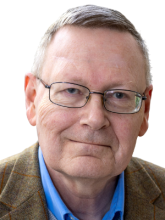Anglo-Saxon attitudes
Scene: A meeting room, London, c.1997. Two actuaries are contemplating a flipchart on which is displayed some mathematics, including a double integral.
Actuary 1: "That's the kind of thing a Danish actuary would understand.'"
Actuary 2: "Yes, but could they calculate a premium rate?'"
Is there such a thing as an `Anglo-Saxon attitude'? And are any to be found in actuarial science? The first question is broad and philosophical, is about caricature as much as fact, and is much too hard for a mere actuary to answer. The second question, on the other hand, it too particular for anyone but an actuary to try to answer. So here goes.
I claim that we do find Anglo-Saxon attitudes in actuarial science. Tempting though it is to go on a one-man chevauchée through the actuarial countryside I will confine myself to one example, namely fear of continuous time.
Students encounter a familiar sequence of ideas in subjects such as mortality and life insurance mathematics, namely:
\[ \mbox{One time period} \rightarrow \mbox{Multiple time periods} \rightarrow \mbox{Continuous time.} \]
Thus 'continuous time' is placed firmly in the 'difficult' box, to be consigned to part (d)(iii) of any exam questions, one hopes, where it can safely be ignored.
There is some truth in this. The idea that \(q\) is the probability of dying during one year, and \((1-q)\) the probability of surviving, is more easily grasped than the idea of \(\mu \, dt\) being the probability of dying during time \(dt\). Moreover, all these \(\mu \, dt\)'s don't seem to add up as they should: instead of a sum \(\int \mu \, dt = q\), we get a product \(\prod (1 - \mu \, dt) = (1 - q)\). Very odd, and it gets worse, that product turns into the exponential of {minus} the sum, \(\exp( - \int \mu \, dt )\) — where did that come from? (For the answer, see my blog on the exponential formula).
Also, it is true that there is no such thing as continuous time when it comes to computation. Even your 64-bit maths or graphics co-processor uses rounded (rational) numbers to approximate to continuous time.
So, to cut a long story short, actuaries get along quite well, admitting continuous time but in a limited way, relegating it to just another example, on a par with cashflows payable monthly or weekly. Which is OK as far as it goes, except for one thing. Continuous time really is more fundamental than discrete time, for a simple reason: it seems to describe nature itself. Until time has been quantized, we cannot avoid asking what happens during any interval of time.
As an example, think about modelling deaths and lapses in a portfolio of life insurance policies. A strictly discrete-time model presents us with a black box. Here is a simple probabilistic formulation: an individual in state {active} at time \(t=0\) is in one of states {dead}, {lapsed} and {active} at time \(t=1\) with probabilities \(p_d\), \(p_l\) and \(1-p_d - p_l\) respectively. We MAY NOT ASK what state the individual is in at time \(t=1/2\). The question is forbidden, as the model does not admit the very concept of time \(t=1/2\). It is like asking how the electron gets from one energy shell to another 'during' a quantum jump, in the Bohr model of the hydrogen atom — just don't ask.
But sometimes we have to ask. The data forces us to. In the example above, individual A may have been observed to die at time \(t=1/2\); how are we to account for this event? Basically we then have two possible approaches:
- Stick with the discrete-time model and invent ad hoc approximate methods to account for what the delinquent individual A should have done during a pristine whole year of exposure — all that the model admits. This leads to the initial exposed-to-risk, and Binomial-type models, which I will describe as being in the Anglo-Saxon tradition.
- Allow that individual A is blameless, and we need a model that accounts for what we actually observe. Then we cannot avoid continuous time; we need a model that accounts for events in an interval of time \(dt\). This leads to the central exposed-to-risk, and Poisson-type models, which I will describe as being in the European tradition, and which form the basis of our book Macdonald, Richards & Currie (2008).
Actuary 1 in the opening scene (which was real, by the way) actually spoke the truth, for Danish actuaries have contributed a great deal to our understanding of the Poisson-type models in case 2 above.
I will end with an example showing that Anglo-Saxon attitudes seem to spring up whenever theory meets practice; actuaries are certainly not alone.
If I dared, I would say we must have a theory — the word 'theory' is so much disliked by so many Englishmen, and is considered by them so 'unpractical', that I avoid it all I can; though I cannot see, myself, that it is very 'practical' to do things without knowing the theory of how to do them.
Wintringham and Blashford-Snell (1973)
References:
Macdonald, A. S., Richards. S. J. and Currie, I. D. (2018). Modelling Mortality with Actuarial Applications. Cambridge University Press, Cambridge.
Wintringham, T. and Blashford-Snell, J.N. (1973). Weapons and Tactics. Penguin Books Ltd., Harmondsworth.
Previous posts
Mortality forecasting in a post-COVID world
Last week I presented at the Longevity 18 conference. My topic was on robustifying stochastic mortality models when the calibrating data contain outliers, such as caused by the COVID-19 pandemic. A copy of the presentation can be downloaded here, which is based on a paper to be presented at an IFoA sessional meeting in N


Add new comment